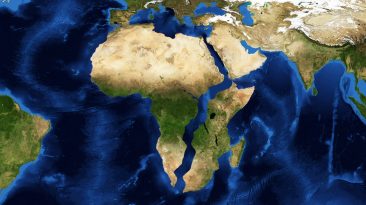How big is the Sun compared to the Earth? Imagine you were able to shrink the Sun to the size of a basketball. At that point, the Earth would be reduced to the size of a sesame seed. That’s how massive our star is.
But what if this fiery ball of gas and plasma wasn’t the biggest thing in our solar system? Would our planet still orbit the Sun? Or would the Sun rotate around the massive Earth? What would happen to our planetary neighbors? What would this hypothetical solar system look like?
Here’s what would happen if the Sun was smaller than the Earth. Put our Sun next to a supergiant star, and you wouldn’t even be able to spot it. But compared to Earth, the Sun is enormous.
It would take the equivalent of 1.3 million Earths to fill up the volume of the Sun. It’s so big that it makes up over 99% of the mass of our entire solar system. It only looks small from Earth because it’s 150 million km (93 million mi) away.
If, hypothetically, the Sun was smaller than the Earth, our solar system would look completely different. The bad news is, the Earth would be uninhabitable, and the Sun… well, this massive star may no longer be a star.
In the universe, size matters. And so does distance.
It just so happens that the Earth is close enough to the Sun that it doesn’t freeze over like Mars. It’s also far enough away that it doesn’t get scorched like Venus.
We’re fortunate to be in the Sun’s habitable zone. This means that the size of our planet, the size of the Sun, and the distance between the two of us, is what has made it possible for life to evolve here on Earth. But, what would happen if the Sun was smaller than our planet?
A star’s mass determines its color and temperature. Bigger stars are hotter and bluer, while smaller ones are cooler and redder. The Sun is a white star – not as big as a supergiant, and not as small as a red dwarf star.
You might think that by making it smaller in size, it would just turn it into a red dwarf with a smaller habitable zone. But that’s not the case. By definition, a star, whether it’s a supergiant or a red dwarf, is only a star when there’s thermonuclear fusion in its core.
How small can stars get? We haven’t measured too many red dwarfs at this point, but the smallest one we came across has a mass of ten Earths. That’s very close to the theoretically necessary size of a star to sustain that fusion. Anything smaller than ten Earths wouldn’t be a star anymore, but rather a cold and dark stellar remnant.
If for any reason the Sun shrank smaller than the Earth, this shrunken Sun wouldn’t have the mass to create fusion and would burn out completely. Our solar system would lose its only star. Since the Sun is the source of gravity that keeps us in orbit, all planets, the Earth included, would float away into space in search of another anchor.
That’s no happy ending for life on Earth.
Let’s try this again. This time, let’s make the Earth bigger than the Sun, while the Sun’s size remains the same.
Earth’s mass would be at least 333,000 times bigger than it is now. Imagine the gravity that planet would have. Your body couldn’t handle a gravitational pull strong enough to crush your bones.
A planet that big would generate enough heat and pressure in its core to become a star itself.
Of course, there would be no life left on this hot star, but here’s a cool thing. Our solar system would then have not just one, but two suns. It would become a binary star system with two stars orbiting around each other, and planets circling them both.
In either scenario, life on Earth would have no chance to survive. But life could possibly evolve on other planets, or even the Moon.
About a third of all stellar systems we’ve found so far are binary or multiple ones. Some of them even have stable habitable zones.
How cool would it be to live on a real-life Tatooine with two suns in the sky?
Subscribe to What-If on Youtube or follow the show on Facebook Watch.
[/expand]




























This is interesting.